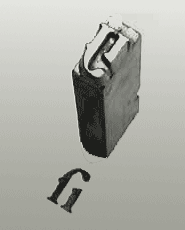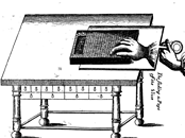| The Mechanization of Writing | |||
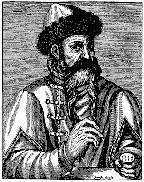 |
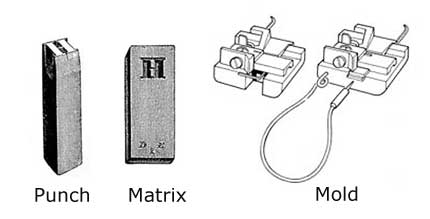 |

Punch and Matrix from De Vinne's Plain Printing Types, 1900 (see"Type Casting.") Image of mold from Typefoundry |
|
| Moveable Type 15th C. Printing had been practiced in Korea, China and Japan for several centuries, and Europeans printed type with carved wooden blocks for about 100 years before a modular moveable type system was developed in Europe about 1450. Was moveable type invented by Gutenberg or Dutch printer Laurens Janszoon Coster? Daniel Berkeley Updike writes this opinion, "Before Gutenberg's day, printing from moveable types was practiced by the Dutch, and there is, perhaps reason to believe that a man named Coster was the inventor of the process ...there certainly existed in Holland before Gutenberg's time, a series of books of primitive workmanship printed from type, and the roughness of the typography of some later printers, like Caxton, is considered one proof that a group of men were under the influence of this Dutch school of printing. It has always puzzled the casual student of incunabula to account for the perfection of the books printed by Gutenberg; but if it be true that Gutenberg did not originate printing from moveable types, but simply improved the the whole practice of making them, then we can see that the early and crude typography of Holland were merely the sub structure on which Gutenberg so splendidly built."1 |
Johannes Gensfleisch Gutenberg (c.1398–1468). Again quoting Updike, " ...whether that which was not first discovered at Mainz had been discovered at Straasburg or in Holland, it was in Germany and at Mainz that the Printed Book as the ambitious rival of the manuscript first came into being." It is believed that Gutenberg learned his metal smithing skills while working with his father at a mint. Whatever the source, Gutenberg was knowledgeable in metal carving and casting, which combined with his penchant for intention, spawned a successful method of "mechanical writing." An early business partnership funded the production of mirrored pins to sell to religious pilgrims passing through his city to Aachen. (Mirrors were believed able to capture holy rays from relics.) Delays in the market for the mirrors led Gutenberg to forge another partnership to fund his work on a secret project —culminating in the printing of small books and calendars. Additionally he raised money by printing papal indulgences (written dispensation for sins) sold by the church. During his secret project Gutenberg learned which metals worked best for each stage of his process — soft enough to create a mold or hard enough to hold up to the pressure of the press. In the 15th century type casting metal was formulated from a combination of lead, tin and pewter—antimony was later added to the formula. Copper or bronze were used for the matrix and steel was used for the punch. |
Gutenberg's System of Casting Individual Metal Type 1. Carve a letter on the end of a steel bar, the punch. In the case of Gutenberg the letter would be a black letter style, not the roman shown in the above example. 2. That letterform is struck into a softer metal bar made of copper, to create a matrix. At this point the letter is right reading. 3. The matrix is placed into a type mold. Molten metal is poured into the opening to fill the mold to produce a wrong reading letter. |
4. The type caster shakes the mold to avoid air pockets and the letterform is almost instantly ready to remove. It is estimated that about 4.000 individual letters could be produced per day. 5. As a final step the cast letterform is released from the mold, cleaned of superfluous metal appendages and leveled for use. The wrong reading letter prints as a right reading final. |
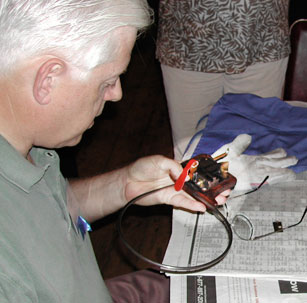 Mr. Stan Nelson, holding a type mold he recreated from working drawings and preparing to cast a single letter of type at the Rare Book School, University of Virginia. Photo ©2008 designhistory.org |
|||
| Gutenberg's Bible | |||
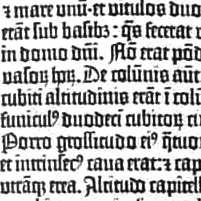 Gutenberg's 42-Line Bible Circa 1455 (See it here!) |
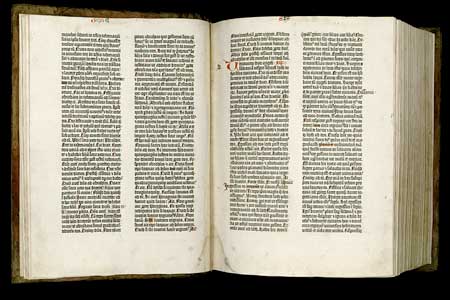 |
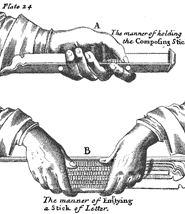 |
|
Research indicates, in an attempt to pay off his business debts, Gutenberg printed papal indulgences (written dispensation for sins) sold by the church. His greatest work, the 42-line bible, is named after the number of lines per column. Printed at the rate of 300 pages per day, each bible in the Gutenberg edition of 200 consisted of over 600 pages bound into two volume sets. When the project was well into the second year, Fust sued Gutenberg for repayment of the loans, plus interest. Gutenberg lost the legal battle as well as his equipment and type. Fust continued the press, using Gutenberg's former employees to complete the next project, a Psalter.
|
The intention of early printers was to make their books resemble manuscripts as closely as possible. Metal letterforms followed manuscript letters as closely as possible. Gutenberg based his letterforms on the liturgical scripts of his era, Textura Quadrata, a form of Blackletter. It has been suggested that Gutenberg included several variations of each letter to mimic the irregularities of handwriting as well as ligatures, or combined letters, that were used by scribes to control letter fitting.
|
Updike writes that the variations on the same letter might not be to mimic handwriting but instead were the result of varying skills of the type casters. "Into such a mold hot metal was poured, and the typecaster then gave it a quick shake, which forced the metal into all the crannies of the matrix. By practice it became apparent that some letters needed a different sort of motion, and were more difficult to make than others, so I suppose that the variations just spoken between the different impressions of the same letter in early fonts may be attributable to the varying skill of the individual workman... mention is made of uncouth movements and swaying figures of gray-haired typecasters, who appear as if demented to anyone who did not know what they were about." 2
|
After final dressing the cast letters were distributed to storage bins. From there they were picked and arranged on a device called a composing stick. (shown above). Each stick was filled and transferred to a tray on a composing table (below).
The entire page form was transferred to the press bed, where it was inked and readied for the paper contact. Despite attempts to keep the process secret, before long there were hundreds of presses operating throughout Germany and Italy. Typesetting images from Moxon's Mechanick exercises: or, The doctrine of handyworks applied to the art of printing. 1683. |
| Related Sites | |||
| (Visit the Gutenberg Museum) |
For an excellent site about a Gutenberg Bible Visit The Harry Ransom Center at the University of Texas at Austin. | There are 48 surviving copies of Gutenberg's bible throughout the world. Go visit one. Here is a list of their locations. |
|
| Footnotes | |||
| 1 Printing Types, their History, Form and Use, Daniel Berkeley Updike, Harvard University Press, Cambridge, 1937,p. 2. |
2 Ibid, p 8. |
||

